Levelling up gender parity locally: Erica Roscoe explains
Article
This International Women’s Day, we take the emphasis on ‘empowering the local level’ highlighted in the recent levelling up white paper to reflect on why gender parity in policymaking is essential, and what can be done to promote it, leading from the local level.
There is extensive evidence that when government is more representative it can lead to more considered and inclusive decision making and encourages a sense of trust among constituents. This applies also to the local level -if local authorities are truly representative of the communities they serve, then the levelling up agenda has the potential (providing it offers authorities the power and the resources they need) to start closing geographic inequalities, as well as firmly embedded societal ones.
Gender and local government in England
According to the 2018 councillor census, at the time of surveying, the majority of local councillors across England were white (96 per cent), aged sixty and above (57 per cent), and male (63 per cent). This highlights how overwhelmingly non-diverse our elected members of local councils are. Based on the changes in the gender split of councillors that occurred between the 2019 and 2021 local elections, evidence shows that gender parity will not be achieved among local councillors until 2077. This is a sobering prospect.
Looking at local government workforce composition shows that over three quarters (78 per cent) of those who carry out the day-to-day activities of local authorities and provide essential services we all rely on are women. However, this does not match or translate into figures on women in leadership positions in local government. Indeed, looking at elected officials, currently women make up just over a third (35 per cent) of councillors in England. Furthermore, according to the most recent data, just one in five council leaders (22 per cent) is a woman. Meanwhile, as of 2017, women made up just under a third (32 per cent) of local government chief executives.
The picture in the north of England
Progress is being made in the North, but the pace of change is still slow. In 2021 the first woman metro mayor was elected in West Yorkshire. Six of the twelve police and crime commissioners in the region are women as are three of the six directly elected (non-metro) mayors.
Across local authorities in the North there is a slightly higher proportion of women councillors at almost four in 10 (39 per cent compared to 35 per cent in England overall). There is also a higher proportion of women council leaders in the region compared to England overall; three in 10 councils in the North have women leaders (31 per cent, compared to 22 per cent across England). In Greater Manchester, there is gender parity across the 10 council chief executives, and the combined authority has established a Women and Girls’ Equality Panel. This aims to address gender inequality and enable women and girls to live their best life in the combined authority area, through co-designing policy and by fostering greater engagement with communities.
And there are other notable policy initiatives across the North aiming to champion the role of women and girls which could, in turn, encourage more women to engage with local government. Liverpool City Region Combined Authority have established a Fairness and Social Justice Advisory Board which is intended to reflect the diversity of the communities across the city region. In other parts of the North, Newcastle City Council launched a ‘16 days of activism’ programme, aimed at raising awareness of violence against women and girls, while in Salford, the city council became the first in England to support Tech She Can, a national programme to increase the number of women working in technology and encourage young girls and women to join the sector. While it’s positive to see new activities established to support women and girls, these should not be just sporadic but need to be embedded across all policymaking.
How devolution could help to ‘level up’ gender parity
It is possible to achieve positive change at a local, regional or national level, and devolution can play a big part in this – but this requires sustained commitment. In Wales, for example, equality was incorporated into devolution legislation, resulting in a world first 50:50 gender representation in the Welsh Assembly in 2003. Subsequently however, this has shifted back to higher numbers of men, demonstrating that gender equality should not be forgotten about once the gender parity box has been ticked once. Political parties must play their part, e.g. actively promoting selection process reform and similar actions. But this should not be the only mechanism for change; a sustained commitment to embedding gender parity into all devolution deals as a key principle would be a meaningful and effective way to shift the dial.
This International Women’s Day is all about breaking the bias – and this is essential if levelling up is to succeed in its aim of bridging the divides that cut across our country. That’s why achieving equality is key - not just across localities and regions, but across different social groups too, particularly those who are disenfranchised and left out of the decision-making process. Local government in places like the North is where policy innovation is going to happen in the months and years ahead – and while some progress has been made, more needs to be done to ensure our local institutions are more representative of a wider range of voices. Any additional devolved power that will ensue from the levelling up agenda should be used to turbocharge the rate of change in local government across every aspect of policymaking, giving a voice to everyone, wherever and whoever they are.
Erica Roscoe is a senior research fellow at IPPR North. She tweets @erica_roscoe.
Related items

The homes that children deserve: Housing policy to support families
As the government seeks to develop a new child poverty strategy, it will need to grapple with housing – the single largest cost faced by families.
Powering up public support for electric vehicles
Tackling greenhouse gas emissions will only work if public support for action remains strong. That means ensuring tangible improvements in people’s lives and heading off any brewing backlash.
Assessing the economy
Over the past few days and weeks, there has been lots of rather histrionic commentary about the UK’s economic situation as if the budget has created an economic disaster from which we’ll never recover.